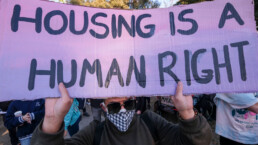In Chicago and across the country, unions and progressive leaders are implementing policies to address the climate crisis while improving working people’s lives.
By Ruthy Gourevitch and Batul Hassan, In These Times
From battling extreme heat on the job to flooding at home, the working class is on the frontlines of extreme weather this summer, fueled by an escalating climate crisis. This crisis is also making life more expensive, from higher utility bills in poorly insulated rental units to medical bills resulting from treatment after days spent in the dangerous heat.
But at a time when the federal government is dismantling the social safety net and climate investments, working class movements are not sitting back and waiting for their bosses, landlords or politicians to act. Instead, labor and tenant unions are taking matters into their own hands, creating a blueprint for how to organize around both the climate and cost of living crises at the same time.
In Chicago, tenants, workers, and climate advocates have united to improve homes and schools. In April, the Chicago Teachers Union ratified a contract that includes repairs and decarbonization investments, including upgrading HVAC equipment and installing heat pumps. The average age for Chicago school buildings is 84 years, with a $3 billion backlog of critical building repairs. As the confluence of the climate crisis and deteriorating facilities — from exposure to toxins like lead and asbestos to an inability to keep classrooms cool through hot days — reach a breaking point, CTU members saw the fight for healthy, green schools as necessary for connecting student learning, health and safety issues, and rising energy costs for the district.

Four years ago, a cohort of CTU teachers and environmental organizers united to win a campaign to stop a toxic industrial metal shredder, General Iron, from opening next to a public school in a majority Latino, working class Southeast Side neighborhood. Since that victory in 2023, environmental leaders in the union continued to build a base behind environmental and climate issues as union-wide priorities.
Through the 2025 contract campaign, teacher-organizers worked steadily to build mass support for green, healthy schools as a topline common good demand. They organized members to walk their coworkers through schools to identify safety hazards, utilized school based committees to advocate for necessary retrofits, and highlighted how malfunctioning HVAC caused lead paint to fall from classroom ceilings. Through listening sessions with members, organizers pushed back on misconceptions that green school demands are no more than greenwashed recycling projects. In both bargaining and messages to the school board, CTU representatives linked how investments in decarbonization projects like rooftop solar can reduce the energy costs of school buildings.
As Lauren Bianchi, Chicago Teachers Union teacher and leader of CTU Climate Justice Committee said at the Socialism 2025 conference, green, healthy schools “are about safe, healthy, joyful learning environments for students. At the end of the day if students are too hot, don’t have drinkable water and good food to eat they can’t have a transformative learning experience.”
Recent Posts
Trump Declares Naval Blockade Against Venezuela As Lawmakers Warn Of Unauthorized Act Of War
December 17, 2025
Take Action Now President Trump’s order to block sanctioned oil tankers near Venezuela escalates military tensions, raises constitutional and…
Democratic Governance Depends On Stable, Affordable Housing
December 16, 2025
Take Action Now A population that cannot afford to stay in one place cannot build civic associations, and a society without civic associations cannot…
The Lobby Is Milking The Bondi Beach Attack To Silence Critics Of Israel’s Genocide
December 16, 2025
Take Action Now It is years of dedicated work by the Israel lobby that has ensured the mass murder of Palestinians is viewed by governments, the…
White House Refuses To Rule Out Summary Executions Of People On Its Secret Domestic Terrorist List
December 15, 2025
Take Action Now The Trump administration ignored questions about whether it would order the killings of those on its NSPM-7 list — even while…




